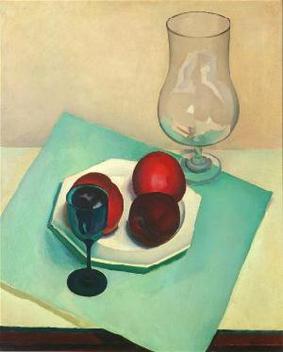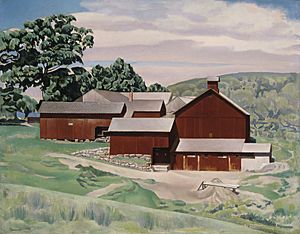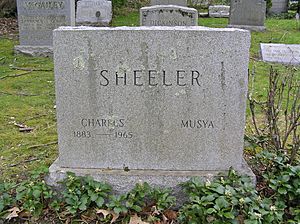Charles Sheeler facts for kids
Quick facts for kids
Charles Sheeler
|
|
|---|---|

Charles Sheeler standing next to a window. c. 1910.
|
|
| Born | July 16, 1883 Philadelphia, Pennsylvania, US
|
| Died | May 7, 1965 (aged 81) |
| Known for | Modern art, Photography |
| Movement | Precisionism, American Modernism |
Charles Sheeler (born July 16, 1883 – died May 7, 1965) was an American artist. He was famous for his unique style of painting called Precisionism. He also did commercial photography and made an important early film called Manhatta. Sheeler is known as one of the first artists to bring modern art to America.
Contents
Early Life and Art Journey
Charles Rettew Sheeler Jr. was born in Philadelphia, Pennsylvania. He studied art at the Pennsylvania Museum School of Industrial Art and later at the Pennsylvania Academy of Fine Arts. One of his teachers was William Merritt Chase.
Sheeler started his career as a painter and showed his work in galleries quite early. He traveled to Italy and France, where he saw art by old Italian painters like Giotto. He was also inspired by new art styles like Cubism from artists such as Pablo Picasso.
When he came back to the United States, Sheeler found it hard to make a living just from modern painting. So, he taught himself photography using a simple Brownie camera. He became a commercial photographer, often taking pictures of buildings.
Sheeler lived in a farmhouse in Doylestown, Pennsylvania. He loved this old house and even called it his "cloister." He took many photos of the house, including its kitchen and stairs. He even photographed his old 19th-century stove, calling it his "companion."
An interesting fact is that Sheeler's art was part of the art competition at the 1932 Summer Olympics.
In 1942, Sheeler started working for the Metropolitan Museum of Art. He was a senior researcher in photography. He photographed many artworks and historical objects for the museum. Sheeler's paintings often looked very precise and almost like photographs, which is why his style is called "Precisionism."
Making the Film Manhatta
In 1920, Sheeler worked with another photographer, Paul Strand. They wanted to create a "portrait" of Manhattan in a film. The short film they made was nine minutes long and was called Manhatta. It was named after a poem by Walt Whitman. This film was the first avant-garde (experimental) movie made in America.
Working with Ford Motor Company
Sheeler was hired by the Ford Motor Company to photograph their factories. He also made paintings of these industrial buildings. This work helped him explore his interest in machinery and modern industry in his art.
Photography and Film Work
Films by Charles Sheeler
- 1921 Manhatta (with Paul Strand)
Photographic Works
- 1917 Doylestown House: Stairs from Below (Metropolitan Museum of Art)
- 1927 Criss-Crossed Conveyors, River Rouge Plant, Ford Motor Company (Metropolitan Museum of Art)
- 1928 Images from Vogue and Vanity Fair
Selected Paintings
Early Works
- Church Street El (1920) – The Cleveland Museum of Art, Cleveland
- Still Life (1925) – M. H. de Young Memorial Museum, San Francisco
- Upper Deck (1928–1929) – Harvard Art Museum, Cambridge, MA
- American Landscape (1930) – Museum of Modern Art, New York City
- Americana (1931) – Metropolitan Museum of Art, New York City
- View of New York (1931) – Boston Museum of Fine Arts, Boston
- River Rouge Plant (1933) – Whitney Museum of American Art, New York City
The Power Series
In 1940, Fortune Magazine asked Sheeler to create a series of six paintings. These paintings showed different types of power and machinery. Sheeler spent a year traveling and taking photos to prepare for this project. He chose subjects like a water wheel, a steam turbine, a railroad, an airplane, and a dam.
- Conversation: Sky and Earth (1939) – Amon Carter Museum of American Art, Fort Worth
- Primitive Power (1939) – The Regis Collection, Minneapolis
- Rolling Power (1939) – Smith College, Northampton
- Steam Turbine (1939) – Butler Institute of American Art, Youngstown
- Suspended Power (1939) – Dallas Museum of Art, Dallas
- Yankee Clipper (1939) – Rhode Island School of Design, Providence
Later Works
- Fugue (1940) – Boston Museum of Fine Arts, Boston
- The Artist Looks at Nature (1943) – Art Institute of Chicago, Chicago
- Water (1945) – Metropolitan Museum of Art, New York
- Incantation (1946) – Brooklyn Museum, Brooklyn
- Amoskeag Canal (1948) – Currier Museum of Art, Manchester
- Windows (1952) – Hirschl & Adler Galleries, New York City
- Conversation Piece (1952) – Reynolda House Museum of American Art, Winston-Salem
- Aerial Gyrations (1953) – San Francisco Museum of Modern Art, San Francisco
- Ore Into Iron (1953) – Boston Museum of Fine Arts, Boston
- Stacks in Celebration (1954) – Dayton Art Institute, Dayton
- Architectural Cadences Number 4 (1954) – Amon Carter Museum of American Art, Fort Worth
- Midwest (1954) – Walker Art Center, Minneapolis
- Golden Gate (1955) – Metropolitan Museum of Art, New York City
- Western Industrial (1955) – Art Institute of Chicago, Chicago
- The Web (1955) – Neuberger Museum of Art, Purchase, NY
- On a Shaker Theme (1956) – Boston Museum of Fine Arts, Boston
Exhibitions
Charles Sheeler's work has been shown in many important art museums. Some of these include:
- "Charles Sheeler: Paintings, Drawings, Photographs" – Museum of Modern Art, New York, 1939.
- "Charles Sheeler: A Retrospective Exhibition" – Art Galleries, University of California at Los Angeles, 1954. This show traveled to several other museums.
- "Charles Sheeler" – National Collection of Fine Arts, Washington, DC, 1968. This show also traveled to the Philadelphia Museum of Art and the Whitney Museum of American Art.
- "Charles Sheeler: Across Media" – National Gallery of Art, Washington, DC, 2006. This exhibition included paintings, photographs, drawings, and a film.
- "The Photography of Charles Sheeler" – Museum of Fine Arts, Boston, 2003. This show featured nearly 100 of his photographs.
Gallery
Paintings
Photographs
See also
 In Spanish: Charles Sheeler para niños
In Spanish: Charles Sheeler para niños


















